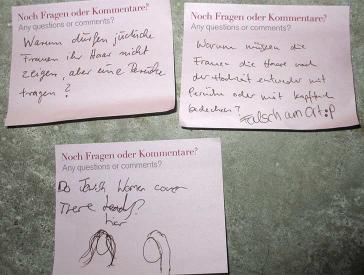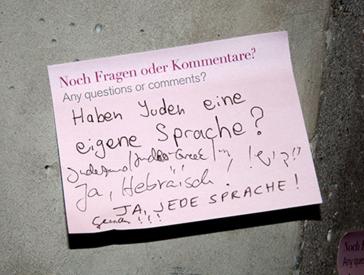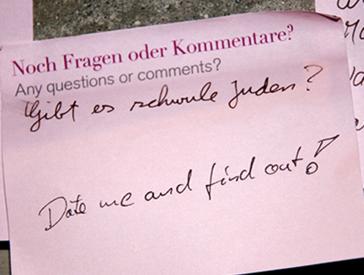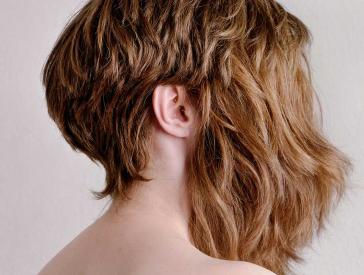“Why do women have to cover their hair with a wig or scarf after getting married?”
Question of the Month in the Context of the Exhibition “The Whole Truth”
Orthodox women do not show their hair in public after their wedding. With a headscarf or a wig – referred to in Yiddish as a sheitel – they signal to their surroundings that they are married and that they comply with traditional notions of propriety.

Questions and commentaries about headscarves in Judaism; Jewish Museum Berlin, photo: Thomas Valentin Harb
The first encounter between Rebekah and Isaac supplied Biblical inspiration for the custom: “Rebekah looked up and saw Isaac. She dismounted from the camel and asked the servant, ‘Who is that man coming towards us across the field?’ The servant replied, ‘That is my master.’ Then she took a veil and covered herself.” (Genesis 24:64ff) Covering the hair became a tradition in the 15th century and has been adhered to in orthodox Judaism ever since.
In the deeply pious Hassidic communities that emerged in Eastern Europe during the 18th century, it was even common for women to cut off all their hair after their wedding and wear a headscarf, called the tichel. Nonetheless, the different strains of orthodoxy gradually varied their interpretation of the custom, from covering the hair entirely after the wedding to only covering some. Today orthodox women cover their hair with a sheitel, scarf, bonnet or beret, or a hairnet.
Regardless of which variant a married woman decides on, she can choose from among many styles. An introduction to binding attractive tichels as well as appealing ways to wear a sheitel can be found on the internet.
These days many women refuse altogether, for the sake of propriety to cover their hair completely.
Miriam Goldmann, Curator for Special Exhibitions
 X
X
From left to right, at the June 16 Yeshivat Maharat ordination ceremony in New York: Rabba Sara Hurwitz (dean of Yeshivat Maharat), Maharat Ruth Balinsky Friedman, Maharat Rachel Kohl Finegold, and Maharat Abby Brown Scheier. Photo by Joan Roth with permission of Yeshivat Maharat.
Citation recommendation:
Miriam Goldmann (2014), “Why do women have to cover their hair with a wig or scarf after getting married?”. Question of the Month in the Context of the Exhibition “The Whole Truth”.
URL: www.jmberlin.de/en/node/6255
Question of the Month: Everything You Always Wanted to Know about Jews (7)











